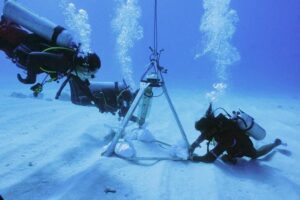
The AWAC acoustic sensors are typically placed on fixed frames in an upwards-looking configuration to record the height and direction of waves. (Credit: CEMarin)
With the 2022 hurricane season upon us, the importance of using science-backed solutions for hurricane preparedness is brought to the foreground. Since Colombia’s Caribbean islands were devastated by hurricanes Eta and Iota within a two-week period back in November 2020, government-funded researchers have been using wave and current data measured by Nortek’s ocean sensors to improve hurricane prediction.
With a total of 14 hurricanes, 2020 was the most active Atlantic hurricane season ever. Experience of Eta and Iota prompted the authorities on the Archipelago of San Andrés, Providencia and Santa Catalina to call for help from the Universidad Nacional de Colombia and the environmental institution CORALINA to develop tools to plan and prepare for future events, including computer modeling to better predict hurricane risk.
Dr. Andrés Fernando Osorio Arias, professor at the Universidad Nacional de Colombia and Executive Director of CEMarin (the Center of Excellence in Marine Sciences), explains:
“We use these models to create reconstructions of hurricanes that have occurred in the past, and also to predict scenarios that have not yet occurred—synthetic scenarios of hurricanes.”
While such models are generally robust, their accuracy is improved by comparison with data measured from the field. This is particularly important as biophysical features such as coral reefs, mangroves and seagrasses can influence sea conditions around islands.
“It’s important to collect information from the field and try to reproduce conditions on a laboratory scale because, in the laboratory, you have more control of the different factors,” says Arias. “With field and laboratory data, you can develop new equations, new parameters and new physical understanding of physical processes to improve the models.”
The scientists gather real-world data on current and wave direction using two AWAC subsea sensors made by Nortek in Norway. These record the motion of the water using calculations based on the Doppler effect, a scientific phenomenon known in the world of physics. The sensors emit sound waves, then measure the echoes that return after bouncing off particles suspended in the water. As waves travel horizontally, these move with the water in a circular, or orbital, motion. This provides insight into how the height and direction of waves varies according to weather conditions.
There are no upcoming events.
